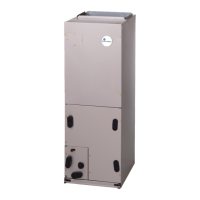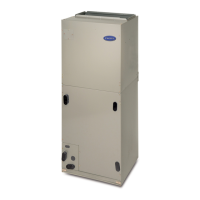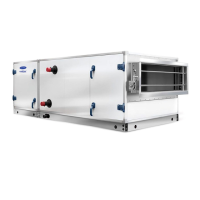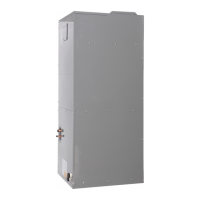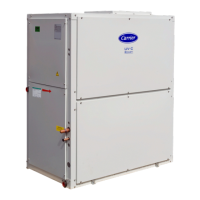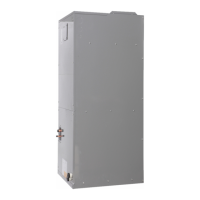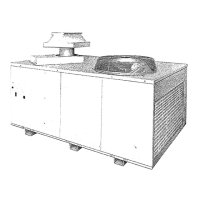88
requires supplemental devices, including a 4 to 20 mA signal, a
10,000 ohms potentiometer, or a discrete switch input, depend-
ing on the method selected. Outside air CO
2
levels may also be
monitored directly and high CO
2
economizer restriction applied
when an outdoor air CO
2
sensor is connected. (The outdoor CO
2
sensor connection requires installation of the CEM.)
The ComfortLink controls have the capability of DCV using an
IAQ sensor. The IAQ is measured using a CO
2
sensor whose
measurements are displayed in parts per million (ppm). The IAQ
sensor can be field-installed in the return duct. There is also an
accessory space IAQ sensor that can be installed directly in the
occupied space. The sensor must provide a 4 to 20 mA output
signal. The sensor connects to TB201 terminals 7 and 8. Be sure
to leave the 182-ohm resistor in place on terminals 7 and 8.
OPERATION
The unit’s indoor air quality algorithm modulates the position of
the economizer damper between two user configurations depend-
ing upon the relationship between the IAQ and the outdoor air
quality (OAQ). Both of these values can be read at the In-
puts
AIR.Q submenu. The lower of these two configurable posi-
tions is referred to as the IAQ Demand Vent Min Position
(IAQ.M), while the higher is referred to as Economizer Minimum
Position (EC.MN). The IAQ.M should be set to an economizer
position that brings in enough fresh air to remove contaminants
and CO
2
generated by sources other than people. The EC.MN val-
ue should be set to an economizer position that brings in enough
fresh air to remove contaminants and CO
2
generated by all sources
including people. The EC.MN value is the design value for maxi-
mum occupancy.
The logic that is used to control the dampers in response to IAQ
conditions is shown in Fig. 12. The ComfortLink controls will be-
gin to open the damper from the IAQ.M position when the IAQ
level begins to exceed the OAQ level by a configurable amount,
which is referred to as Differential Air Quality Low Limit
(DAQ.L).
If OAQ is not being measured, OAQ can be manually configured.
It should be set at around 400 to 450 ppm or measured with a
handheld sensor during the commissioning of the unit. The OAQ
reference level can be set using the OAQ Reference Set Point
(OAQ.U). When the differential between IAQ and OAQ reaches
the configurable Diff. Air Quality Hi Limit (DAQ.H), then the
economizer position will be EC.MN.
When the IAQ–OAQ differential is between DAQ.L and DAQ.H,
the control will modulate the damper between IAQ.M and
EC.MN as shown in Fig. 12. The relationship is a linear relation-
ship but other non-linear options can be used. The damper position
will never exceed the bounds specified by IAQ.M and EC.MN
during IAQ control.
If the building is occupied and the indoor fan is running and the
differential between IAQ and OAQ is less than DAQ.L, the econo-
mizer will remain at IAQ.M. The economizer will not close com-
pletely. The damper position will be 0 when the fan is not running
or the building is unoccupied. The damper position may exceed
EC.MN in order to provide free cooling.
The ComfortLink controls are configured for air quality sensors
which provide 4 mA at 0 ppm and 20 mA at 2000 ppm. If a sensor
has a different range, these bounds must be reconfigured. These
pertinent configurations for ranging the air quality sensors are
IQ.R.L, IQ.R.H, OQ.R.L, and OQ.R.H. The bounds represent the
PPM corresponding to 4 mA (low) and 20 mA (high) for IAQ and
OAQ, respectively.
If OAQ exceeds the OAQ Lockout Value (OAQ.L), then the econ-
omizer will remain at IAQ.M. This is used to limit the use of out-
side air which outdoor air CO
2
levels are above the OAQ.L limit.
Normally a linear control of the damper vs. the IAQ control signal
can be used, but the control also supports non-linear control. Dif-
ferent curves can be used based on the Diff.IAQ Responsiveness
Variable (IAQ.R). See Fig. 13.
Fig. 12 — IAQ Control
Fig. 13 — IAQ Response Curve
SETTING UP THE SYSTEM
The IAQ configuration options are under the Local Display Mode
Configuration
IAQ. See Table 69.
100
500
700
1000
INSIDE/OUTSIDE CO
2
DIFFERENTIAL
INSIDE CO
2
CONCENTRATION
AQ
DIFFERENTIAL
LOW (DAQ.L)
AQ
DIFFERENTIAL
HIGH (DAQ.H)
MINIMUM
IAQ
DAMPER
POSITION
ECONOMIZER
MINIMUM
DAMPER
POSITION
INCREASING VENTILATION
VENTILATION FOR PEOPLE
VENTILATION FOR SOURCES
NOTE: Calculating the IAQ.M and EC.MN damper position based on differential
IAQ measurement. Based on the configuration parameter IAQREACT, the reac-
tion to damper positioning based on differential air quality ppm can be adjusted.
IAQREACT = 1 to 5 (more responsive)
IAQREACT = 0 (linear)
IAQREACT = –1 to –5 (less responsive)

